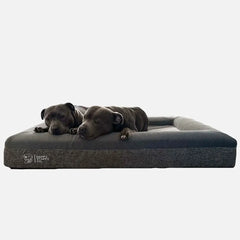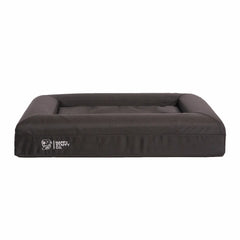
There’s something heartwarming about watching your dog lose themselves in the simple pleasure of chewing their favourite toy. It’s a quiet reminder of how small choices can make a big difference, because when a toy fits perfectly, it nurtures your dog’s wellbeing, keeps their mind active, and spares your furniture from damage.
Choosing the right size, however, goes beyond what looks tough or cute on the shelf. It begins with understanding your dog’s breed, age, temperament, and bite strength, then pairing that insight with durable, well‑designed materials that truly suit their needs. The right chew toy is one that matches your dog's breed and age, striking the ideal balance of safety, comfort, and engagement so every chew feels rewarding and natural.
Key Takeaways
-
Proper sizing prevents choking and dental damage. Always choose a chew toy large enough to extend beyond both sides of your dog’s mouth.
-
Breed and age directly affect chew strength and material choice. Match toy toughness to your dog’s jaw power and life stage for safer, longer play.
-
Material quality determines safety and satisfaction. Non-toxic nylon toys keep dogs engaged without breaking apart.
-
Regular inspection avoids health risks. Replace toys that show cracks, thinning, or missing pieces to prevent accidental swallowing.
-
Personalized selection enhances wellbeing. The right chew toy supports your dog’s mental stimulation, dental health, and overall happiness.
Why Getting the Right Size and Type of Chew Toy Matters
Chewing is not just playtime. It’s a biological need. Dogs chew to explore the world, to relieve stress, to soothe teething discomfort, and to keep their jaws strong. It’s their version of meditation, exercise, and dental hygiene all rolled into one. A well-sized chew toy provides resistance and texture that helps scrape away plaque while keeping their gums stimulated. Without a good chew outlet, frustration builds up, and that’s when furniture, shoes, or table legs become fair game.
Risks of the wrong size
The wrong size toy can turn a harmless habit into an emergency. A small toy can slip down a larger dog’s throat, while an oversized or rock-hard toy can cause jaw strain. Choosing an appropriate size minimises these risks and allows your dog to chew naturally without discomfort or danger.
How breed, age and size influence chewing needs
Every breed has its own chewing personality. A small-breed Cavoodle won’t need the same resistance level as a determined Staffy. Puppies have gentler jaws and growing teeth that benefit from softer materials, while adult dogs often need durable toys that challenge their bite. Seniors, on the other hand, may require something gentler yet still engaging to maintain their interest.
Understanding Your Dog: Breed, Age, and Size Factors

Breed categories and chewing tendencies
Breed influences how dogs interact with their toys. Each breed brings different chewing habits and preferences.
Toy and Small Breeds (Maltese, Pomeranian, Cavoodle):
-
Prefer lightweight toys that they can easily pick up and carry.
-
Soft textures and flexible materials make playtime more enjoyable.
-
Look for toys that compress slightly to protect small teeth.
Medium Breeds (Kelpie, Border Collie, Cocker Spaniel, Staffy):
-
Thrive on toys that challenge their mind and muscles.
-
Interactive options such as tug ropes or puzzle chew toys encourage both problem-solving and jaw strength.
-
Textured designs keep them engaged for longer sessions.
Large & Giant Breeds (Labrador, Rottweiler, Great Dane):
-
Need solid, oversized toys built to withstand heavy chewing.
-
Opt for reinforced rubber or dense nylon toys that resist crumbling.
-
Heavy-duty designs provide safe, long-lasting satisfaction.
Different breeds have unique preferences and chewing strengths, so matching toy size and material to their physical build and temperament ensures comfort, safety, and lasting play.
Age stages and how chewing needs change
Puppy Stage
-
When teeth begin to erupt, puppies naturally seek relief by gnawing.
-
Soft rubber or cooling toys are ideal as they help soothe sore gums without hurting delicate teeth.
-
Chilled chew toys or textured designs provide added comfort and stimulation during teething.
Adult Stage
-
Once your dog reaches adulthood, chewing becomes an outlet for enjoyment, exercise, and stress relief.
-
Tougher materials like nylon or reinforced rubber work best for maintaining jaw strength and reducing boredom.
-
Introduce toys that encourage interaction, such as puzzle or treat-dispensing toys.
Senior Stage
-
Older dogs often prefer a slower, gentler chew.
-
Their bite pressure may decrease, and their teeth can become sensitive, making softer rubber or fabric-based toys a perfect match.
-
Lightweight toys and plush textures help keep them engaged without discomfort.
Size/weight guide and how it affects toy size recommendations
Weight matters when it comes to toy sizing. A general rule is that the toy should be large enough to stick out from either side of your dog’s mouth. It should never fit entirely inside. Lightweight breeds need small or medium toys that are easy to manipulate, while heavier dogs need thicker, more substantial toys for leverage.
Individual chewing style & temperament
Not all chewers are created equal. Some nibble gently, while others go full demolition mode. Observe how your dog treats their toys; do they shred them in minutes, or simply hold and lick them? Knowing your dog’s chewing style can save you from replacing toys weekly and ensure your pup gets something that matches their energy.
How to Choose the Right Size Chew Toy: Step-by-Step
Measure Your Dog’s Jaw Size
Start with observation. Watch how your dog handles existing toys. Measure across the widest part of their jaw and look for toys slightly larger than that width. The toy should challenge their mouth without feeling uncomfortable.
Follow the Rule of Thumb
A safe chew toy should never fit entirely inside your dog’s mouth. It needs to extend out both sides so it cannot be accidentally swallowed. Always choose a toy one size up if you’re unsure.
Match Toy Size to Dog Weight
Manufacturers often include sizing charts based on dog weight. As a guide:
-
Toy breeds under 5kg need extra-small toys
-
Small breeds up to 10kg use small toys
-
Medium dogs up to 25kg fit medium toys
-
Large dogs over 25kg should always go large or extra-large
Adjust for Growth and Age
As puppies mature, their jaw strength increases rapidly. Replace toys every few months to ensure they’re always challenged and safe. What fits a 4‑month‑old pup may become a choking hazard by their first birthday.
Check for Wear and Upgrade Regularly
No toy lasts forever. Inspect toys weekly for deep bite marks, cracks, or thinning areas. Once a toy starts breaking down, it’s time to replace it. A fresh, sturdy option keeps your dog’s chewing safe and satisfying.
Material & Durability Considerations Depending on Size and Age

Common Materials
Each material offers a different experience:
-
Rubber is versatile and provides bounce.
-
Nylon is tough and durable.
-
Rope helps clean teeth during play.
-
Edible chews give quick satisfaction but wear down faster.
-
Antlers and hooves suit strong chewers but must be monitored for safety.
Best Materials by Age and Size
-
Puppies: Need flexible toys like soft rubber or fabric for teething.
-
Adults: Do best with dense rubber or nylon for strength and jaw exercise.
-
Seniors: Prefer gentle options like plush or silicone to protect sensitive teeth.
Durability and Safety
-
A toy that’s too soft breaks easily.
-
One that’s too hard can hurt your dog’s teeth.
-
Press with a fingernail; if it leaves a mark, it’s the right firmness.
Safe and Clean Materials
Choose non-toxic, BPA-free toys from trusted brands. Clean them often with mild soap and warm water, and skip harsh chemicals that could leave residue.
Breed-Specific Recommendations & Examples
|
Breed Category |
Example Breeds |
Recommended Toy Size |
Ideal Materials |
Key Features |
|
Toy & Small |
Chihuahua, Pomeranian, Cavoodle |
Extra-small to Small |
Soft rubber, fleece, plush |
Lightweight, compressible, squeaky |
|
Medium |
Beagle, Border Collie, Cocker Spaniel, Staffy |
Medium |
Textured rubber, rope, nylon |
Interactive, durable, textured |
|
Large & Giant |
Labrador, Rottweiler, Great Dane |
Large to Extra-large |
Reinforced rubber, nylon |
Heavy-duty, power chewer safe |
|
Special-case |
Bulldog, Cavalier King Charles, older breeds |
Varies |
Soft rubber, silicone, fabric |
Gentle on jaws, dental-friendly |
Toy & Small Breeds (Chihuahua, Pomeranian)
Small dogs benefit from toys that are light enough to toss and carry. Soft rubber or fleece-based toys work well and keep their play safe. Squeaky or bouncy designs bring out their playful nature and encourage gentle exercise.
Medium Breeds (Beagle, Staffy)
Medium-sized dogs appreciate a mix of toughness and texture. Textured rubber bones or rope tugs satisfy both their strength and curiosity. Interactive toys help keep them mentally sharp and physically active.
Large & Giant Breeds (Labrador, Great Dane)
These dogs need toys built for power and endurance. Reinforced rubber or nylon bones can withstand heavy pressure. Choose designs built for “power chewers” that last longer and reduce the risk of breakage.
Special-case Breeds (Bulldogs, dental-sensitive dogs)
Flat-faced breeds often prefer wider, flatter toys that don’t strain their jaws. Dogs with weaker teeth benefit from soft, flexible materials that still provide texture. Gentle resistance helps maintain dental health without discomfort.
Safety Checklist & Maintenance Tips
-
Check and Replace Regularly: Inspect chew toys every week. If they’re thinning, cracking, or losing chunks, replace them immediately. Regular rotation keeps things exciting and safe.
-
Supervise New Toys: When introducing a new toy, stay nearby. Observe how your dog interacts with it and ensure it’s the right size. The first few minutes reveal whether it’s a good fit.
-
Keep Toys Clean: Toys accumulate saliva and bacteria quickly. Wash rubber and nylon toys weekly, and replace fabric or rope toys more often if they start to smell or show wear.
-
Discard Damaged Toys: Once a toy develops jagged edges or missing pieces, it’s time to say goodbye. Damaged toys are safety hazards, even if your dog seems attached to them.
-
Watch for Hazards: Be alert for warning signs such as coughing, pawing at the mouth, or sudden loss of interest. Always choose reputable brands and avoid cheap imports that may not meet safety standards.
Choosing Chew Toys That Grow With Your Dog
Finding the right chew toy is about more than playtime; it’s about supporting your dog’s growth, comfort, and confidence. Each stage of life brings different needs, and every breed brings its own quirks. When we match size, strength, and personality with the right toy, we set our dogs up for joy and safety in every chew.
At Happy Staffy, we’ve learned that no two dogs are the same, and that’s what makes this journey beautiful. The right chew toy can turn boredom into happiness, calm into excitement, and a quiet afternoon into a moment of pure tail-wagging bliss. Our goal is to make those moments last with toys that fit perfectly, feel safe, and bring joy to every bite.



